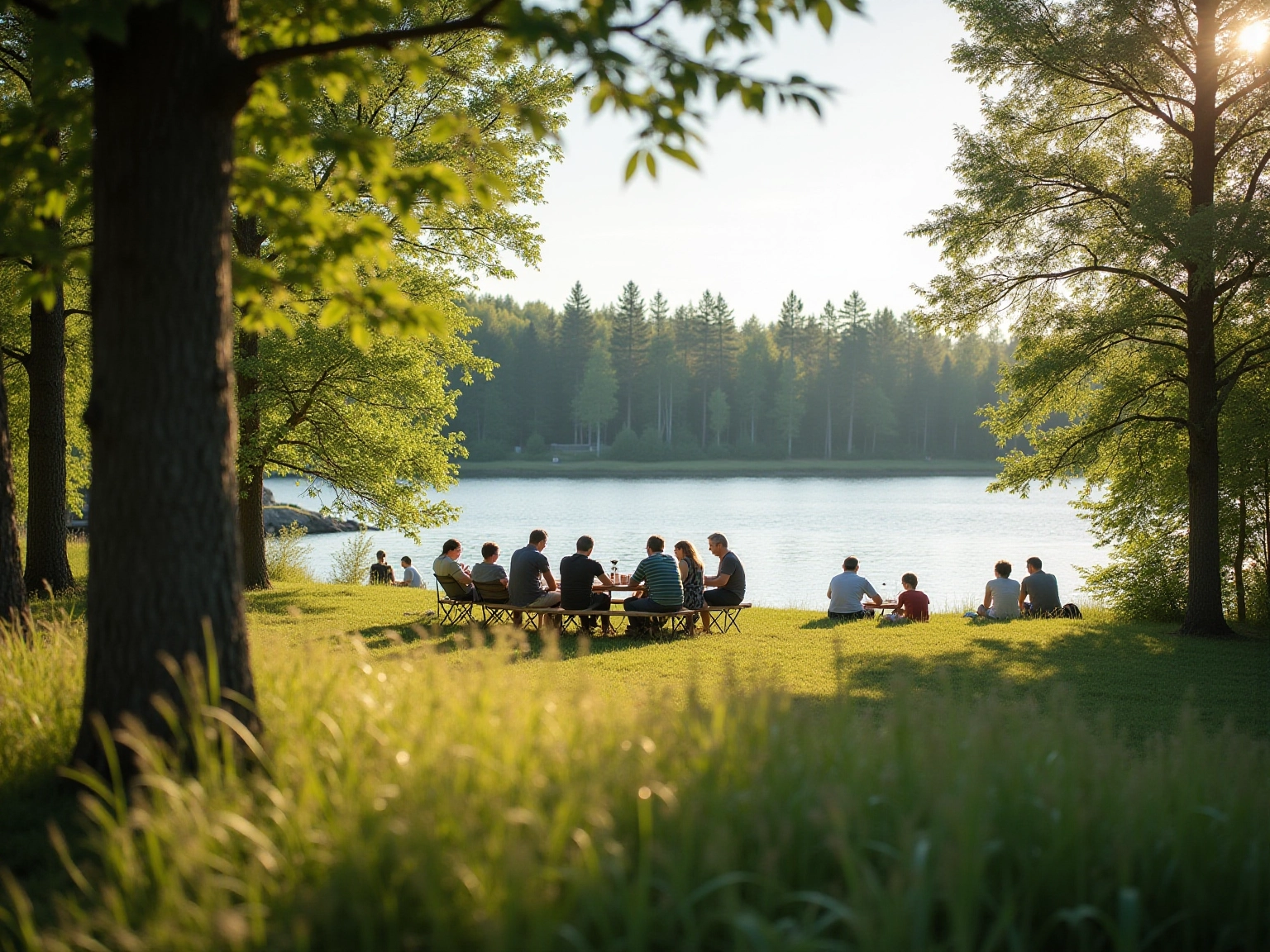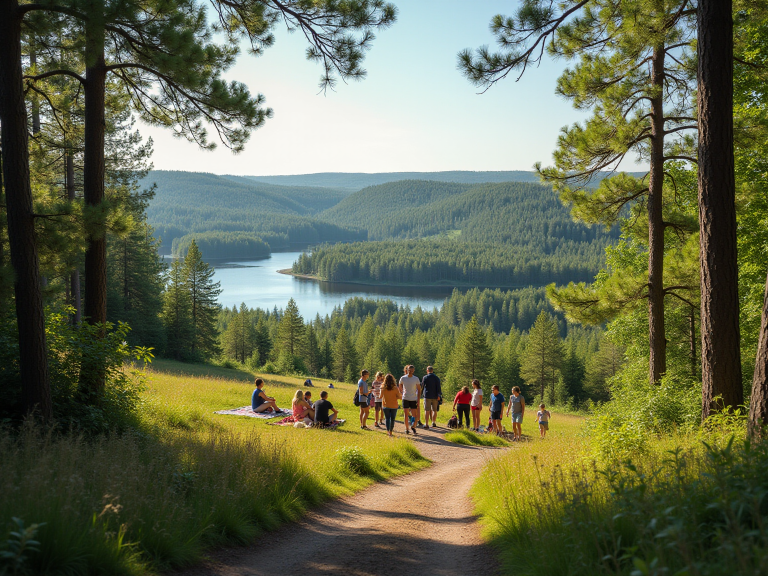Overview
Have you ever wondered what makes Finland the happiest place to live in the world? It’s all about their effective social systems, strong community trust, and a culture that really emphasizes equality and a connection with nature! Imagine living in a place where comprehensive social welfare policies, a balanced work-leisure lifestyle, and a focus on resilience and community engagement come together to create an incredible sense of well-being and life satisfaction.
In Finland, these factors are more than just policies—they’re a way of life! It’s fascinating how these elements contribute to the happiness of its citizens. You can almost feel the warmth of the community and the joy of living in harmony with nature. So, if you’re looking for inspiration or a new adventure, Finland might just be the perfect destination for you!
Key Highlights:
- Finland has been ranked the happiest country in the world for eight consecutive years, reflecting effective social systems and policies.
- Key factors contributing to Finnish happiness include income equality, social support, and community trust.
- The rise of the gig economy poses challenges for employment stability among young adults in Finland.
- Finnish culture emphasizes simplicity, equality, and a strong connection with nature, enhancing individual well-being.
- The concept of ‘sisu’ represents resilience and determination, fostering a positive outlook among Finns.
- Education in Finland prioritizes student well-being and creativity over standardized testing, promoting joy and fulfillment.
- Comprehensive social welfare policies, including universal healthcare and generous parental leave, support overall quality of life.
- Community engagement and volunteerism are encouraged, fostering social cohesion and a sense of purpose.
- Nature plays a vital role in Finnish happiness, with significant access to forests and lakes promoting outdoor activities.
- The Finnish lifestyle balances work and leisure, prioritizing relaxation and well-being.
Introduction
In a world that seems increasingly obsessed with material success, have you ever wondered what true happiness looks like? Finland shines as a beacon of genuine joy, consistently topping global happiness rankings! The Finnish way of life goes beyond just economic measures; it beautifully intertwines societal trust, equality, and a deep connection to nature.
By exploring the rich blend of cultural values, strong social policies, and community engagement, we can uncover the secrets behind Finland’s remarkable ability to nurture individual happiness. As this incredible nation celebrates its eighth consecutive year as the happiest country, diving into these elements reveals not just a model for happiness, but a profound understanding of what it truly means to thrive in a supportive society.
So, are you ready to discover what makes Finland so special?
Defining Happiness: Finland’s Unique Position
Happiness is such a fascinating topic, isn’t it? According to the World Happiness Report, it’s a complex idea that weaves together factors like income, social support, longevity, freedom to make choices, generosity, and perceptions of corruption. In 2025, Finland proudly held onto its title as the happiest country in the world for the eighth year in a row! This achievement not only reflects the well-being of its citizens but also highlights how effective its social systems and policies are in enhancing quality of life.
You see, the Finnish view of well-being is deeply connected to societal trust, equality, and a strong sense of community. These elements work together beautifully to create a supportive atmosphere that boosts individual happiness. It’s no wonder Finland is celebrated as the happiest place to live in the world!
The World Happiness Report 2025 shares that Finland’s success stems from its commitment to economic stability and fair resource distribution, which play significant roles in life satisfaction. Case studies show that lower income inequality and well-structured social systems are key to fostering well-being among its citizens. However, it’s important to note that the rise of the gig economy and fewer secure, long-term job opportunities have created some uncertainty for many young adults. This highlights the ongoing need to focus on employment stability as a crucial factor in well-being.
Experts point out that Finland’s approach to well-being goes beyond just economic measures. It emphasizes the overall welfare of individuals within a nurturing community. As Sumit Arora, a team lead and current affairs writer, puts it, “Through well-researched and thoughtfully crafted content, I aim to guide and support candidates on their journey to success.” This really underscores the importance of informed perspectives in understanding well-being.
And let’s not forget! Fostering a culture of empathy and mutual support can significantly enhance the well-being and longevity of community members. This further illustrates how cultural context contributes to the nation’s impressive well-being ranking. This unique blend of elements positions Finland not only as a leader in well-being rankings but also as the happiest place to live in the world, exemplifying what a thriving society can achieve.

Cultural Influences on Happiness in Finland
Finnish culture, which embodies the happiest place to live in the world, is all about simplicity, equality, and a deep connection with nature—values that play a huge role in well-being. At the heart of this cultural vibe is the concept of ‘sisu,’ which captures resilience and determination, empowering Finns to face challenges with a positive outlook. You’ll find that communal activities, like sauna gatherings and outdoor festivals, are essential for building social ties and a sense of belonging, reinforcing those community connections that really boost individual well-being. As conversations around well-being in Finland highlight, nurturing trust and community participation is key!
Now, let’s talk about education! Finland’s approach emphasizes student well-being and creativity over rigid standardized testing. This creates an atmosphere where joy and personal fulfillment thrive. It’s no wonder this holistic educational philosophy contributes to a culture where individuals feel valued and connected, significantly enhancing overall life satisfaction. A report on family structures and well-being shows that policies supporting diverse family dynamics can elevate well-being levels across various societies, underscoring the importance of community in Finnish culture.
As travel host and author Karen LeBlanc beautifully puts it, “Every destination has a narrative to share through its local art, architecture, culture, and craft.” This highlights how these cultural elements weave together to create a nurturing environment that promotes personal well-being and strengthens community bonds. The interplay of these cultural components not only fosters personal happiness but also highlights how Finnish culture contributes to making it the happiest place to live in the world, emphasizing how authenticity and creativity in design and community involvement enrich our lives.
Key Policies Supporting Well-Being in Finland
Have you ever wondered what makes a country the happiest place to live in the world? Well, Finland’s remarkable happiness ranking is a key reason why it is often regarded as the happiest place to live in the world, largely attributed to its comprehensive social welfare policies! Imagine a place where universal healthcare, free education, and a robust social security system ensure that everyone has access to essential services. How wonderful is that?
These policies are not just about basic needs; they’re complemented by initiatives that promote gender equality and work-life balance, significantly enhancing the overall quality of life. For instance, did you know that Finland’s parental leave policies are among the most generous in the world? This allows parents to bond with their little ones without the stress of financial strain—such a relief!
But that’s not all! The Finnish government also encourages community engagement and volunteerism, creating a wonderful sense of social cohesion and purpose among its citizens. These policies not only boost individual well-being but also nurture a culture of trust and cooperation, essential for creating the happiest place to live in the world. As Honna beautifully puts it, “Finnish happiness is really more about contentedness and being at peace.” And this sentiment is echoed by statistics showing that Finns truly feel a strong sense of contentedness and peace in their lives.
Let’s not forget the cultural significance of saunas in Finland! With over two million saunas linked to various health benefits, it’s fascinating how traditional practices contribute to overall well-being. Plus, the resilience and adaptability of Finns, especially when dealing with seasonal changes, further enhance their contentment. Experts emphasize that these qualities are essential to their happiness. Isn’t it inspiring to see how these elements come together to create such a vibrant, happy society?
The Role of Nature and Lifestyle in Finnish Happiness
Nature is such a wonderful source of joy for Finns! Did you know that around 74% of the country is covered in forests, dotted with countless lakes and parks that everyone can enjoy? This rich tapestry of natural beauty really showcases how intertwined nature is with local culture. Thanks to the principle of ‘everyman’s rights,’ you can freely explore these stunning spaces, inviting you to dive into outdoor activities like hiking, skiing, and swimming. Research even shows that spending time in nature can significantly reduce stress and boost mental health, which is fantastic for your overall well-being.
In Finland, the lifestyle beautifully balances work and leisure, making relaxation and well-being a priority. This deep-rooted connection to nature, paired with a cultural appreciation for simplicity and mindfulness, contributes to making it the happiest place to live in the world where happiness can truly flourish. Plus, initiatives like the Climate Therapy Podcast by HSY highlight community efforts encouraging citizens to engage in environmental stewardship. It’s such a great resource for locals to learn about climate issues and get involved, emphasizing how local culture nurtures a connection to nature.
So, the Finnish lifestyle not only celebrates the breathtaking outdoors but also acknowledges its profound impact on mental health and overall life satisfaction. As one expert wisely noted, ‘Success in sustainability work requires long-term efforts at every stage of the entire value chain.’ This really underscores the importance of a sustained commitment to caring for our environment!
Conclusion
Finland’s remarkable status as the happiest country in the world is a delightful blend of cultural values, effective social policies, and a strong connection to nature. The Finnish understanding of happiness emphasizes societal trust, equality, and community engagement, creating an environment that nurtures individual well-being and fosters social bonds.
Imagine this: key cultural elements, like ‘sisu’—which embodies resilience—and communal activities, enhance personal fulfillment and reinforce community ties. Plus, Finland’s education system prioritizes student well-being and creativity, contributing to a culture that truly values happiness.
Comprehensive social welfare policies, including universal healthcare and generous parental leave, ensure that all citizens have access to essential services. This promotes trust and cooperation among everyone. And let’s not forget Finland’s relationship with nature! Access to green spaces and outdoor activities significantly boosts mental health, enhancing overall happiness.
In essence, Finland serves as a powerful model for understanding happiness holistically. By prioritizing social equity, community bonds, and a deep appreciation for nature, this nation illustrates that true happiness arises from a supportive environment that empowers individuals. The insights gained from Finland underscore the importance of fostering both personal and communal well-being as essential components of a thriving society. So, what can you take away from this? Embrace the idea that happiness is a collective journey, one that flourishes in a nurturing environment!
Frequently Asked Questions
What factors contribute to happiness according to the World Happiness Report?
The World Happiness Report indicates that happiness is influenced by factors such as income, social support, longevity, freedom to make choices, generosity, and perceptions of corruption.
Which country was ranked as the happiest in the world in 2025?
In 2025, Finland was ranked as the happiest country in the world for the eighth consecutive year.
What elements contribute to Finland’s high levels of happiness?
Finland’s high levels of happiness are attributed to societal trust, equality, a strong sense of community, economic stability, and fair resource distribution.
How does income inequality affect well-being in Finland?
Lower income inequality and well-structured social systems are key factors that foster well-being among Finnish citizens, as highlighted by case studies.
What challenges do young adults in Finland face regarding employment?
The rise of the gig economy and fewer secure, long-term job opportunities have created uncertainty for many young adults in Finland, emphasizing the need for employment stability.
How does Finland’s approach to well-being differ from solely economic measures?
Finland’s approach to well-being extends beyond economic measures to focus on the overall welfare of individuals within a nurturing community.
What role does community support play in enhancing well-being in Finland?
Fostering a culture of empathy and mutual support significantly enhances the well-being and longevity of community members, contributing to Finland’s impressive well-being ranking.































